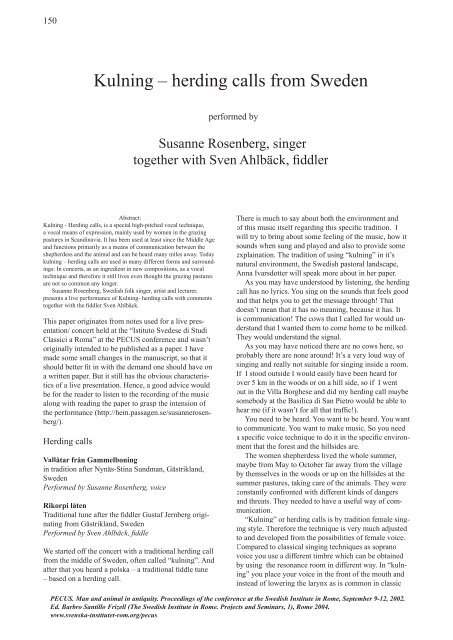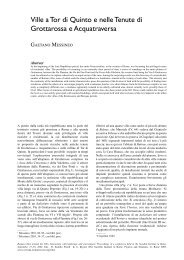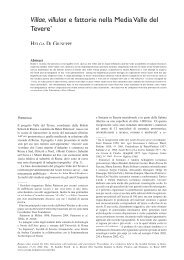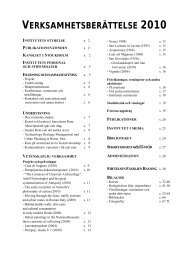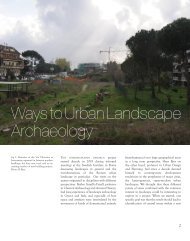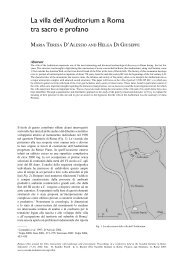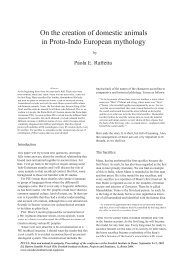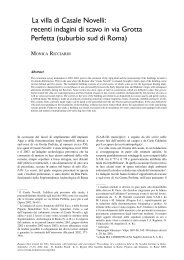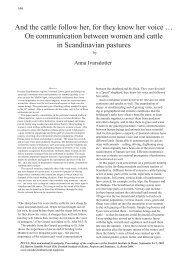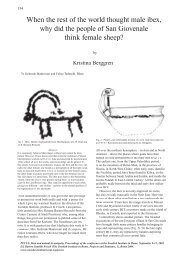Kulning â herding calls from Sweden - Svenska Institutet i Rom
Kulning â herding calls from Sweden - Svenska Institutet i Rom
Kulning â herding calls from Sweden - Svenska Institutet i Rom
You also want an ePaper? Increase the reach of your titles
YUMPU automatically turns print PDFs into web optimized ePapers that Google loves.
150<br />
<strong>Kulning</strong> – <strong>herding</strong> <strong>calls</strong> <strong>from</strong> <strong>Sweden</strong><br />
performed by<br />
Susanne Rosenberg, singer<br />
together with Sven Ahlbäck, fiddler<br />
Abstract:<br />
<strong>Kulning</strong> - Herding <strong>calls</strong>, is a special high-pitched vocal technique,<br />
a vocal means of expression, mainly used by women in the grazing<br />
pastures in Scandinavia. It has been used at least since the Middle Age<br />
and functions primarily as a means of communication between the<br />
shepherdess and the animal and can be heard many miles away. Today<br />
kulning – <strong>herding</strong> <strong>calls</strong> are used in many different forms and surroundings:<br />
In concerts, as an ingredient in new compositions, as a vocal<br />
technique and therefore it still lives even thought the grazing pastures<br />
are not so common any longer.<br />
Susanne Rosenberg, Swedish folk singer, artist and lecturer,<br />
presents a live performance of <strong>Kulning</strong>- <strong>herding</strong> <strong>calls</strong> with comments<br />
together with the fiddler Sven Ahlbäck.<br />
This paper originates <strong>from</strong> notes used for a live presentation/<br />
concert held at the “Istituto Svedese di Studi<br />
Classici a <strong>Rom</strong>a” at the PECUS conference and wasn’t<br />
originally intended to be published as a paper. I have<br />
made some small changes in the manuscript, so that it<br />
should better fit in with the demand one should have on<br />
a written paper. But it still has the obvious characteristics<br />
of a live presentation. Hence, a good advice would<br />
be for the reader to listen to the recording of the music<br />
along with reading the paper to grasp the intension of<br />
the performance (http://hem.passagen.se/susannerosenberg/).<br />
Herding <strong>calls</strong><br />
Vallåtar från Gammelboning<br />
in tradition after Nynäs-Stina Sundman, Gästrikland,<br />
<strong>Sweden</strong><br />
Performed by Susanne Rosenberg, voice<br />
Rikorpi låten<br />
Traditional tune after the fiddler Gustaf Jernberg originating<br />
<strong>from</strong> Gästrikland, <strong>Sweden</strong><br />
Performed by Sven Ahlbäck, fiddle<br />
We started off the concert with a traditional <strong>herding</strong> call<br />
<strong>from</strong> the middle of <strong>Sweden</strong>, often called “kulning”. And<br />
after that you heard a polska – a traditional fiddle tune<br />
– based on a <strong>herding</strong> call.<br />
There is much to say about both the environment and<br />
of this music itself regarding this specific tradition. I<br />
will try to bring about some feeling of the music, how it<br />
sounds when sung and played and also to provide some<br />
explaination. The tradition of using “kulning” in it’s<br />
natural environment, the Swedish pastoral landscape,<br />
Anna Ivarsdotter will speak more about in her paper.<br />
As you may have understood by listening, the <strong>herding</strong><br />
call has no lyrics. You sing on the sounds that feels good<br />
and that helps you to get the message through! That<br />
doesn’t mean that it has no meaning, because it has. It<br />
is communication! The cows that I called for would understand<br />
that I wanted them to come home to be milked.<br />
They would understand the signal.<br />
As you may have noticed there are no cows here, so<br />
probably there are none around! It’s a very loud way of<br />
singing and really not suitable for singing inside a room.<br />
If I stood outside I would easily have been heard for<br />
over 5 km in the woods or on a hill side, so if I went<br />
out in the Villa Borghese and did my <strong>herding</strong> call maybe<br />
somebody at the Basilica di San Pietro would be able to<br />
hear me (if it wasn’t for all that traffic!).<br />
You need to be heard. You want to be heard. You want<br />
to communicate. You want to make music. So you need<br />
a specific voice technique to do it in the specific environment<br />
that the forest and the hillsides are.<br />
The women shepherdess lived the whole summer,<br />
maybe <strong>from</strong> May to October far away <strong>from</strong> the village<br />
by themselves in the woods or up on the hillsides at the<br />
summer pastures, taking care of the animals. They were<br />
constantly confronted with different kinds of dangers<br />
and threats. They needed to have a useful way of communication.<br />
“<strong>Kulning</strong>” or <strong>herding</strong> <strong>calls</strong> is by tradition female singing<br />
style. Therefore the technique is very much adjusted<br />
to and developed <strong>from</strong> the possibilities of female voice.<br />
Compared to classical singing techniques as soprano<br />
voice you use a different timbre which can be obtained<br />
by using the resonance room in different way. In “kulning”<br />
you place your voice in the front of the mouth and<br />
instead of lowering the larynx as is common in classic<br />
PECUS. Man and animal in antiquity. Proceedings of the conference at the Swedish Institute in <strong>Rom</strong>e, September 9-12, 2002.<br />
Ed. Barbro Santillo Frizell (The Swedish Institute in <strong>Rom</strong>e. Projects and Seminars, 1), <strong>Rom</strong>e 2004.<br />
www.svenska-institutet-rom.org/pecus
Susanne Rosenberg, singer together with Sven Ahlbäck, fiddler<br />
151<br />
singing you slightly raise it. The nasality of the sound<br />
and the way of starting every phrase and tone with a<br />
slight “pickup” also helps the sound to be straight and<br />
keep a clear direction of the voice. You often use the<br />
difference between the chest voice and the head voice<br />
to emphasize the originality of sounds. Especially when<br />
you do short, quick phrases often for small and quick<br />
animals like sheep and goat!<br />
Grazing songs<br />
But <strong>herding</strong> <strong>calls</strong> is not the only music used in the pastoral<br />
landscape. There is also other music that in one way<br />
or another is connected with the <strong>herding</strong> environment.<br />
Music that does not have that obvious function for communication<br />
but is just as important anyway. Songs that<br />
tells us a lot about the special working environment for<br />
the women in the forests. This music has got lyrics.<br />
I will sing you four small songs that actually all of<br />
them tell the same story. The songs are <strong>from</strong> different<br />
parts of <strong>Sweden</strong>, <strong>from</strong> north to south, but they all come<br />
<strong>from</strong> areas where <strong>herding</strong> has been practiced and the<br />
tonality has the same features as in the music you heard<br />
before.<br />
These songs comment on the dangerous and hard life<br />
that the women lived under during the summer, and tells<br />
us that there are a lot of things in the wood to beware of<br />
and to be afraid of: Thieves and robbers, wild animals as<br />
bears and wolves… There is a special phrase that always<br />
comes back in these songs and that is: “Twelve men in<br />
the wood”– and that could both actually mean “twelve<br />
men” that are around in the wood, maybe thieves and<br />
robbers, but it can also mean the dangerous bear that is<br />
said to have the strength of twelve men.<br />
The songs usually have a poetic touch. And it’s quite<br />
hard to translate as you can imagine. The lyrics is often<br />
sung with alliterations and rhymes and in dialect, so the<br />
translation below is just a very brief word by word translation,<br />
together with the Swedish lyric for you to get a<br />
hint of what the songs are about.<br />
Stor’n stejn (The big stone)<br />
Grazing song <strong>from</strong> Jämtland , <strong>Sweden</strong><br />
Performed by Susanne Rosenberg, voice<br />
Ja klettre opp på´n stor´n stejn,<br />
lure så de höurles allt hejm:<br />
Till tilleri torom,<br />
tolv männer i skogom,<br />
tolv kära vära dom.<br />
Småhunnan hängde dom,<br />
gehll´nbarna skrämde dom,<br />
storoxen dängde dom.<br />
Allt sen je höusle<br />
a Gullros mi gaule<br />
långt, långt, långt långt<br />
sönna Dårfjälle.<br />
I climbed up on a big stone<br />
blow my birch-bark horn so they<br />
could hear it all the way home<br />
till tilleri torom<br />
twelve men in the forest<br />
Twelve men they are<br />
They hang the small dogs<br />
They frighten the small goats<br />
They hit the big ox<br />
And at the same time I heard<br />
(my cow) Gullros (Golden rose)<br />
mooing<br />
far, far, far, far away<br />
South of the Fools mountain<br />
Ling, linge logen<br />
Grazing song after Lena Larsson, Bohuslän, <strong>Sweden</strong><br />
Performed by Susanne Rosenberg, voice<br />
Ling linge logen<br />
Tolfte man i skogen<br />
Bjällekoe bunne’<br />
Fy hundar hänge<br />
Locka mig långt<br />
uti Dårefjället gör de<br />
Där varken vatten eller vete<br />
Där gror löken, där gal göken<br />
Där är bätter än här<br />
Där är gossar att leka med<br />
Ling, linge logen<br />
Twelve men in the forest<br />
The bell-cow they tie<br />
The dogs they hang<br />
And they lure/entice me into the<br />
Fools mountain<br />
Where there is neither water nor<br />
wheat<br />
There the onion grows, and the<br />
cookoo call<br />
There is better than here<br />
There are boys to play with<br />
Ti tu le lu le lu<br />
Grazing song after Eva Eriksson, Gästrikland , <strong>Sweden</strong><br />
Performed by Susanne Rosenberg, voice<br />
Ti tu le lu le lu<br />
Ti tu le lu le lu<br />
Högt uppi berge’<br />
High up in the mountain<br />
Vad vill du?<br />
What do you want?<br />
Jag vill låna stora kitteln uta’ dej I want to borrow the big stew-pan<br />
<strong>from</strong> you<br />
Vad skâ du me’ den?<br />
What do you want with that?<br />
Jag ska koka stora lassen I shall cook for Saturday night<br />
till lörda’ kväll<br />
Vallhund’ hängande<br />
The shepherd’s dog they hang<br />
Skällkon bindande<br />
The bell-cow they bind<br />
Stor Oxen stingande<br />
The big Ox they stab<br />
Fôlk kom å hjälp mej nu! People please come and help me!<br />
Ja’ sitter ibland tolv skälmar här. I sit among twelve robbers here<br />
Stora Oxen/ The big ox<br />
Grazing song after Anna-Britta Moberg, Gästrikland,<br />
<strong>Sweden</strong><br />
Performed by Susanne Rosenberg, voice<br />
Stora Oxen ha de slagi’ The big oxe they have hit<br />
Röda kon ha di tagi’<br />
The red cow they have taken<br />
Å mej hänga de’<br />
And they hang me up<br />
å mej hänga de’<br />
å mej hänga de opp!<br />
Skynden, skynden, skynden ’å! Hurry up!<br />
Skynden, skynden, skynden ’å!<br />
För rövarna i skogen gå The robbers are in the forest<br />
Kom nu!<br />
Please come at once<br />
But then there are also songs that put a more humoristic<br />
view to the life of the summer pastures. You can<br />
understand by the lyrics to this next song that this is in<br />
the tradition of <strong>herding</strong>. The lyrics doesn’t really mean<br />
anything, it’s mostly just good words to sing on. But<br />
anyway there is a lot of goats and cheese and “stuff” that<br />
is clearly connected with the summer pastoral way of<br />
living. This is really some fine lyrics and great poetry,<br />
isn’t it, especially the last verse!<br />
Lillgubben<br />
Grazing song after Eva Eriksson, Gästrikland, <strong>Sweden</strong><br />
Performed by Susanne Rosenberg, voice<br />
Lillgubben uppå tallbacken,<br />
två döttrar hade han.<br />
The little man on the pine slope<br />
He had two daughters
152<br />
<strong>Kulning</strong> – <strong>herding</strong> <strong>calls</strong> <strong>from</strong> <strong>Sweden</strong><br />
Sålde bort sina skinnbyxor<br />
å köfte stintorna gullband.<br />
Getlycka, lôppsôcka,<br />
min get å ja’ me’.<br />
Mine getter går i skogen<br />
å gnaver barsken ‘tå trä.<br />
Östnola på Gångbra berget,<br />
där växer ett killingabet.<br />
Då vi ska ut å geta<br />
då ska vi fara dit.<br />
Lillguben uppå tallbacken<br />
Sot Olle speleman<br />
Pannkaka slô tebaka<br />
sötosten kom fram.<br />
Hej hyfsa på killinga byfsa<br />
tre kilo te luvo<br />
En rö en å en blå en<br />
å en mitt uppå kullo.<br />
Mine getter skiter böner,<br />
granngårdsstinten plôck upp,<br />
kokar sig en bönvälling,<br />
å så säger dom att de e’ gott!<br />
He sold away his leather trousers<br />
And bought gold ribbons to the girls<br />
Goat happiness, flee stockings<br />
My goat and myself<br />
My goats walks in the woods<br />
And gnaw off the bark <strong>from</strong> the trees<br />
East on the mountain of good walking<br />
There grows good kid grazing<br />
When we go out with the goats<br />
Then we will go there<br />
Little man on the pine slope<br />
Soot Olle, fiddler<br />
Pancake hit back<br />
The sweet cheese is coming<br />
Hallo, put order to your goat trousers<br />
three kilo for a knitted cap<br />
one red and one blue<br />
And one right on the top of the head.<br />
My goats shit beans<br />
The neighbours’ girls pick them up<br />
Make themeselves a bean porridge<br />
And say that it tastes good!<br />
Hia hia<br />
Traditional polska tune <strong>from</strong> Härjedalen, <strong>Sweden</strong><br />
Performed by Sven Ahlbäck, fiddle<br />
After this great lyrics you heard again a polska that was<br />
inspired <strong>from</strong> the tonality and form of this very song. Or<br />
maybe it’s the other way around. This is something that<br />
we really can’t tell. This is music that you learn by the<br />
ear. You learn it <strong>from</strong> someone and it doesn’t matter if<br />
there is any author back many hundred years ago, you<br />
really don’t care. It’s how you learnt it and especially<br />
who you learnt it <strong>from</strong> that is important.<br />
A <strong>herding</strong> call is mostly improvised – you call for<br />
someone or something and you can never know in advance<br />
how long time you have to call. It’s like a cradle<br />
songs, you have to sing until the baby goes asleep or in<br />
this case until the cow comes home.<br />
When you create and improvise the music you use<br />
small traditional melodic themes that you vary all the<br />
time. Usually I improvise – but because I want to show<br />
you a little more of different styles You will hear what<br />
could be regarded as a fixed improvisation. An improvisation<br />
that is clearly inspired <strong>from</strong> different shepherdess<br />
and different types of <strong>calls</strong> .- for cows, goats, sheep…<br />
and maybe there is also some calling for a men in this<br />
to!<br />
Hommage á Karin<br />
Traditional <strong>herding</strong> <strong>calls</strong> <strong>from</strong> Scandinavia<br />
Performed by Susanne Rosenberg, voice<br />
Other music in the summer pastures<br />
In this summer pasture there is not only the voice. There<br />
is also instruments as birch-bark horn, goat horn and<br />
Fig. 1. Girl <strong>from</strong> Gästrikland, <strong>Sweden</strong>. Blowing the horn in the forest.<br />
Drawing by Richard Dybeck, <strong>from</strong> “brev från Dalarna och Norrland”<br />
1847, letters to a colleague.<br />
cow horn (Fig.<br />
1). And melodies that are played on this<br />
instruments. Sven will play a beautiful cow horn melody<br />
on his fiddle and after that we will take a religious song<br />
that again has this special tonality that characterizes the<br />
<strong>herding</strong> music. The polska that is played after that is in<br />
it’s turn inspired by the song. Or once again, maybe it’s<br />
the opposite; maybe the polska has inspired the song and<br />
the <strong>herding</strong> tune?<br />
The religious song has very nice lyrics which is about<br />
how you should rejoice the day that you were born. So<br />
this is a song that you could sing for your self to celebrate<br />
that happy occasion.<br />
Vallåten efter Hjort Anders<br />
In tradition after Ole Hjorth, Stockholm<br />
Performed by Sven Ahlbäck, fi ddle<br />
Min fö<br />
delsedag/ My birthday<br />
Traditional religous song after Finn Jonas Jonsson,<br />
Dalarna<br />
Performed by Susanne Rosenberg, voice and Sven Ahlbäck,<br />
fi ddle<br />
Min Födelsedag fö<br />
rtjänar att jag The day I was born deserves that I<br />
Ett tacksamhetsljud<br />
Send a sound of greatfulness<br />
Till himmelen sänder att prisa to heaven to praise the lord<br />
min Gud<br />
Som skapat mig väl<br />
That He did create me well<br />
Att jag av hans händer So that I <strong>from</strong> His hand<br />
få<br />
tt lemmar och själ<br />
got both body and soul
Susanne Rosenberg, singer together with Sven Ahlbäck, fiddler<br />
153<br />
Av skaparen bygd<br />
Created by the Lord<br />
I moderlivets skygd<br />
in my mothers womb<br />
Jag fången än låg<br />
still captured I was<br />
Med öron ej hörde med ögon ej såg Didn’t hear with my ears and<br />
didn’t see with my eyes<br />
Min boning var trång I didn’t have much room<br />
Jag stundom mig rörde So I moved about to get<br />
att slippa mitt tvång<br />
out<br />
Vid tidens förlopp<br />
As time went along,<br />
bröts fängelset opp<br />
my prison was opened<br />
Gud förde mig ut<br />
The Lord brought me out<br />
På trängsel och mörker var lyckligen slut The darkness was ended<br />
Då skådade jag<br />
And then I saw people, villages and<br />
Folk byar och kyrkor vid himmelens dag churches at this heavenly<br />
day.<br />
Gråtlåten/ the crying tune<br />
Polska after Hjort-Anders, Dalarna<br />
Performed by Sven Ahlbäck, fiddle<br />
Herding <strong>calls</strong> today<br />
Now we will end our concert with a new piece of music.<br />
Today – as you might have understand already – this<br />
<strong>herding</strong> music have found new ways to be heard. This<br />
occasion or concert is proof of that!<br />
Herding call or “kulning” is today used mostly outside<br />
the environment that it was created in and therefore it<br />
also has possibilities to survive while the natural environment<br />
has not. And for me it’s a beautiful and powerful<br />
way of using the voice both for making music and to<br />
communicate.<br />
I’ve used “kulning” in concerts in Tokyo and New<br />
York, with and without national costume, preventing<br />
getting assaulted in Stockholm and calling and founding<br />
lost friends in Helsinki. I’ve been using this technique<br />
both in new composed art music and with traditional<br />
folk music groups.<br />
To sum up we will therefore end with a new tune that<br />
Sven wrote. This new <strong>herding</strong> call and polska he wrote<br />
last year for a concert in New York, were we performed<br />
it together with orchestra and folk soloist <strong>from</strong> all over<br />
the world.<br />
Nya vallåten<br />
Composed by Sven Ahlbäck, 2001<br />
Peformed by Susanne Rosenberg, voice and Sven Ahlbäck,<br />
fi ddle<br />
Susanne Rosenberg<br />
Susanne Rosenberg, Folk singer<br />
Senior lecturer, Royal University of Music in Stockholm<br />
Department of Folk music,<br />
Box 27711, 115 91 Stockholm, <strong>Sweden</strong><br />
susanne.rosenberg@kmh.se<br />
and<br />
Sven Ahlbäck, fiddler<br />
Assisting professor, Royal University of Music Stockholm<br />
Department of Folk music,<br />
Box 27711, 115 91 Stockholm, <strong>Sweden</strong><br />
sven.ahlback@kmh.se<br />
Music example 1-9 arranged by Susanne Rosenberg and Sven Ahlbäck,<br />
Music example 10 composed by Sven Ahlbäck<br />
© Copyright of the music: Udda Toner www.uddatoner.com / Susanne Rosenberg & Sven Ahlbäck 2003<br />
published by kind permission of the holder of copyright.<br />
CD’s with traditional <strong>herding</strong> call:<br />
”Lockrop och vallåtar” / Caprice 21483 www.caprice.rikskonserter.se/<br />
”Swedish Pastoral Music”/ Hurv KRCD-28: www.hurv.com


